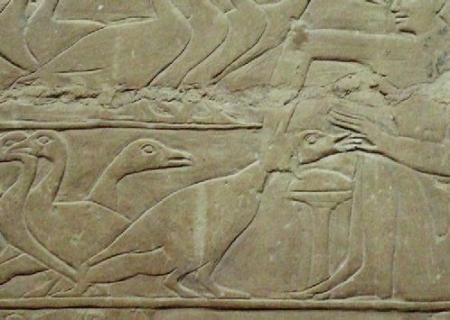History of Foie Gras
Category : Food Stories, Party Ideas, Recipes, Press Room |
Posted : Apr 25, 2014
Literally translated from French, foie gras means "fat liver," but its origins date back far before French cooking made it a delicacy. The ancient Egyptians hunted and then domesticated geese, and discovered that waterfowl developed large, fatty livers after eating large amounts in preparation for migration. To replicate this naturally occurring large liver, the Egyptians, over 4000 years ago, developed the technique now known as gavage to produce a fattier bird.
Colorful relief paintings found on the tombs of aristocratic Egyptians depict the hand-feeding of geese, which served as an important source of nutrition around the Nile region. The practice of gavage spread throughout the Mediterranean, and was adopted by the Greeks and then the Romans, the latter of whom made foie gras into a delicacy in its own right.
As Rome expanded territorially, its gastronomic influence also expanded, turning foie gras into a food enjoyed by gourmands, who fattened their ducks explicitly for the purposes of its production. After the fall of Rome, and during the medieval period, it was the Jewish population who kept the tradition of foie gras alive. Goose meat served as an excellent source of nutrition and the animal also provided cooking fat that conformed to Jewish law. Wherever Jews moved across Europe during the Middle Ages, they brought with them the tradition of goose fattening.
During the late sixteenth-century Renaissance, classical texts and cookbooks were revisited, and interest in foie gras was once again piqued. In France, Louis XIV, a gourmand, enjoyed haute cuisine, but his tastes began to trickle down to the aspirations of the French middle class. After the French Revolution, with centuries of food admiration so deeply etched into their culture, the bourgeois became the new consumers of cuisine, and they began to frequent a new establishment known as the restaurant. Chefs who had lost their aristocratic patrons cooked instead for Parisian middle class society.
Foie gras became popularized in the United States in the late nineteenth century as Americans brought a love of the food back with them from travels in Europe. It was not until the latter part of the twentieth century, however, that American farmers began to produce foie gras here in the U.S. The majority of foie gras consumed by Americans now comes from small North American farms. Demand for foie gras has grown, prompting chefs across the country to add the item to their menus. And though it has enjoyed a long history, foie gras is still produced using the traditional methods passed down by generations – by hand, and with care and attention that small, artisan farmers give to their ducks.
 Closeup of Egyptian tomb relief showing the feeding of ducks. Excerpts from www.artisanfarmers.org
Closeup of Egyptian tomb relief showing the feeding of ducks. Excerpts from www.artisanfarmers.org













